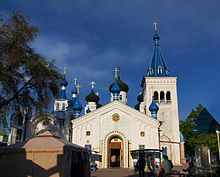
Christianity in Kyrgyzstan


| Christianity by country |
|---|
 |
|
|
Christianity has a long history in Kyrgyzstan, with the earliest archaeological remains of churches belonging to the Church of the East in modern-day Suyab dating back to the 7th century. By the 9th century an archdiocese of the Church of the East cared for the Christians of Kyrgyzstan and adjacent areas in eastern Turkestan.[1] Although primarily Turkic there was also an Armenian community in what today is Kyrgyzstan by the 14th century. By the 15th century, however, there were no longer ecclesiastical structures of any church caring for what is today Kyrgyzstan and Islam gained the ascendancy amongst the Kyrgyz people.

Demographics
In 2020, figures showed that 4.39% of the population followed Christianity, with 3.53% of the population identifying as Orthodox, 0.31% as Protestant, 0.01% as Catholic and 0.61% as other Christian.[2]

Eastern Orthodox Christianity is the largest Christian denomination in Kyrgyzstan, with members primarily comprising the country's ethnic Russians and Ukrainians. A small minority of ethnic Germans are also Christian, mostly Lutheran and Anabaptist, with Baptists, Pentecostals, evangelicals and Adventists also active in the country.[3][4] At least 92,000 Christians are from majority Muslim ethnic groups.

Discrimination against Christians has been reported in 2022.[5]

A 2015 study estimates some 19,000 Christians from a Muslim background residing in the country, though not all are necessarily citizens of Kyrgyzstan.[6] While other scholars estimated the total number of Muslim Kyrgyz converts to Christianity between 25,000[7] to 50,000, although the government disputes that figure.[8] Exact numbers of Muslim Kyrgyz converts to Christianity vary but an estimate of around 20,000 is generally accepted among scholars.[9]

Orthodox Christian Church

The modern history of Orthodoxy in Kyrgyzstan dates back to the country's incorporation into the Russian Empire in the late 19th century. The first parishes in Kyrgyzstan were opened in Bishkek, Naryn, and Osh in the 1870s to serve the Russian forts being built in the country.[10] The military parishes were eventually recognized as regular parishes as the Russian Orthodox Church presence in Kyrgyzstan grew. In 1871 the Holy Synod of the Russian Orthodox Church established a diocese - the Eparchy of Tashkent and Turkestan - for its new communities in Central Asia, with the new parishes in Kyrgyzstan coming under its authority.[11] By the time of the Russian Revolution in 1917 there were over 30 churches in what today is Kyrgyzstan.[12] It was also home to one of three Orthodox monasteries in Central Asia at the time, Holy Trinity Monastery on the shores of Lake Issyk Kul.[13]

During the Soviet era Orthodoxy in Kyrgyzstan suffered from persecution as it did elsewhere in the USSR. Clergy and laity alike were murdered by the new authorities and many churches were closed and destroyed. As part of the easing of the persecutions during World War II many churches were reopened, with thirty-two active in Kyrgyzstan by 1946.[14] Eight were later closed in the renewed persecutions under Khrushchev.

Since the collapse of the Soviet Union the number of Orthodox parishes in Kyrgyzstan has nearly doubled to forty-four.[15] A new women's monastery has also been established in Kara-Balta in northern Kyrgyzstan. In 2011 the Holy Synod of the Russian Orthodox Church decided to separate the Orthodox Church in Kyrgyzstan from the Eparchy of Tashkent and establish it as its own diocese, the Eparchy of Bishkek under the Bishop of Bishkek and Kyrgyzstan.[16] The new diocese was included in the Russian Orthodox Church's Ecclesiastical province of Central Asia.[17]

Roman Catholic Church
The Catholic Church has been mentioned in this region since the 14th century, mainly in the territory of today’s Kazakhstan. The Roman Catholic missionaries came to Kyrgyzstan mainly from China, until the turn of the 19th and 20th centuries. From 1918 to 1930, the area of Kyrgyzstan came under the parish of Tashkent. In 1937, a persecution of Roman Catholic Church began, and the churches were destroyed and all priests were deported or executed. In that time, because of mass deportations into Central Asia (that had no parallel even in the tsar era), an influx of Catholics arrived from the Volga area, Ukraine, Poland and Baltic Sea area. On 13 May 1991, the apostolic administration of Kazakhstan and Central Asia was created and included five post-Soviet Central Asian republics, from which four gained a status of mission sui iuris later – the church in Kyrgyzstan did so on 22 December 1997. Sui iuris means that it is an autonomous unit – an independent juristic person, based on its own discipline, heritage, or culture – but it is in full communion with the Pope in Rome.[18]

There were 268 Christians in Kyrgyzstan in 1999. Part of them were descendants of German, Polish, Latvian and Lithuanian deportees and parts were citizens of other states (diplomats, workers of international organisations).

On 18 March 2006, the apostolic administration in Kyrgyzstan was founded (defined as a region under the administration of any clergyman authorised by the pope), now under the administration of bishop Nicolas Messmer, who was born (similarly as his predecessor in the administration of Kyrgyzstan Alexander Kan) in Kazakh's Karaghanda. The relationship to Kazakh's bishopric is very strong, and the Catholic literature and hymnals are printed in Kazakhstan.

In the capital, Bishkek, there is a church (among the associated societies belong e.g. Belovodskoe, Chaldybar, Tuz, Nurmanbet, Ivanovka, Iskra, Niznevostochnoe, Kamyshanovka, Oktjabrskoe), and the worships in Talas take place in a bought house, there was also a newly founded parish on the south of Kyrgyzstan (Djalalabad and Osh) too, and another parish is in Karakol.

In Bishkek, up to now, the Roman Catholic Church has been associated with the German population and therefore the church used to be marked as “German” by the Kyrgyz (немецкая церковь) – contrary to the Orthodox church, which is considered “Russian” (русская церковь). Among the visitors of the church (except the foreigners) are Bishkek citizens of German origin (although they do not speak German), and there are also descendants of Poles.


See also
References
- ^ "История Православия Кыргызстана".
- ^ World Religion Database on the ARDA website, retrieved 2023-08-08
- ^ US State Dept 2022 report
- ^ Religion in Kyrgyzstan Archived 2006-09-01 at the Wayback Machine
- ^ Open Doors website
- ^ Johnstone, Patrick; Miller, Duane Alexander (2015). "Believers in Christ from a Muslim Background: A Global Census". IJRR. 11 (10): 1–19. Retrieved 30 October 2015.
- ^ Religion and the Secular State in Kyrgyzstan
- ^ Kyrgyzstan keeps a tight grip on religion
- ^ Akçalı, Pınar (2013). Politics, Identity and Education in Central Asia: Post-Soviet Kyrgyzstan. Routledge. ISBN 9781135627676.
- ^ "История Православия Кыргызстана".
- ^ "Ташкентская епархия / Организации / Патриархия.ru".
- ^ "История Православия Кыргызстана".
- ^ "История Православия Кыргызстана".
- ^ "История Православия Кыргызстана".
- ^ "Бишкекская епархия / Организации / Патриархия.ru".
- ^ "Бишкекская епархия / Организации / Патриархия.ru".
- ^ "Среднеазиатский митрополичий округ Русской Православной Церкви / Организации / Патриархия.ru".
- ^ Kokaisl, Petr; Kokaislová, Pavla The Kyrgyz - Children of Manas. Кыргыздар – Манастын балдары. Prague / Прага: Alterra and Za hranice: Společnost pro rozvojovou spolupráci při Provozně ekonomické fakultě ČZU v Praze. Fellowship for development cooperation, 2009. ISBN 978-80-254-6365-9, p. 103-106.
External links
See what we do next...
OR
By submitting your email or phone number, you're giving mschf permission to send you email and/or recurring marketing texts. Data rates may apply. Text stop to cancel, help for help.
Success: You're subscribed now !
